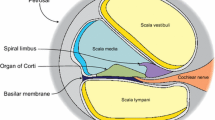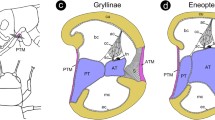Summary
Cystosoma saundersii is a cicada in which the male is specialised for the production of low frequency (800 Hz) sound. The basic anatomical and physiological features of its auditory system are examined in males and females.
-
1.
Paired auditory (chordotonal) organs are located in auditory capsules on the second abdominal segment (Figs. 6, 9 A). Each auditory organ is suspended between a distal attachment horn and a proximal apodeme (Figs 5B, 7A, B) connected to a complex tympanum (Figs. 4, 10). Male and female tympana are approximately equal in area. Male tympana are loaded (Figs. 5A, 7C) with masses of amorphous material.
-
2.
Both tympana are coupled into a single abdominal air chamber which, in males, almost fills the enlarged abdomen, but in females occupies a restricted volue within the abdomen (Fig. 8).
-
3.
Male and female auditory organs are both sharply tuned to the frequency of the species' song at 800 Hz (Figs. 11, 12).
-
4.
Each female auditory organ exhibits a directional sensitivity which is limited to frequencies near 800 Hz but males lack directional hearing (Figs. 13, 14).
-
5.
The enlarged male abdomen acts as an omnidirectional receiver of sound at frequencies near 800 Hz, which results in an augmented sound pressure at the inside surfaces of the tympana (Figs. 15, 16). However, male and female absolute sensitivities at the hearing optima are similar (Figs. 11, 12) which indicates reduced sensitivity of the male tympana.
-
6.
We conclude that the auditory system ofC. saundersii is finely adapted to the requirements of intraspecific acoustic communication with low frequency sound.
Similar content being viewed by others
Abbreviations
- A1–A4 :
-
abdominal segments 1–4
- att h :
-
attachment horn
- audc :
-
auditory capsule
- aud n :
-
auditory nerve
- aud o :
-
auditory organ
- chit V arm :
-
lateral arm of chitinous V
- chit V base :
-
basal portion of chitinous V
- det o :
-
detensor chordotonal organ
- det t m :
-
detensor tympani muscle
- fold mem :
-
folded membrane
- ind :
-
indentation
- lat m :
-
lateral abdominal muscle
- op :
-
operculum
- phr:
-
phragma
- pro :
-
protuberance
- sp :
-
spiracle
- T2-3 :
-
thoracic segments 2 (mesofhorax) and 3 (metathorax)
- tens t m :
-
tensor tympani muscle
- tr :
-
trachea
- tr mem :
-
tracheal membrane
- tr sac :
-
tracheal sac
- tymb :
-
tymbal
- tymb h :
-
tymbal homologue
- tymb m :
-
tymbal muscle
- tymp :
-
tympanum
- t apo :
-
tympanal apodeme
- t bar :
-
tymbal bar
- t co :
-
tympanal cover
- t load :
-
tympanal loading
- t rid :
-
tympanal ridge
- V. bar :
-
vertical bar
- υn c :
-
ventral nerve cord
References
Enger, P.S., Aidley, D.J., Szabo, T.: Sound reception in the Brazilian cicada,Fidicina rana Walk. J. exp. Biol.51, 339–345 (1969)
Hill, K.G., Boyan, G.S.: Directional hearing in crickets. Nature (Lond.)262, 390–391 (1976)
Katsuki, Y., Suga, N.: Electrophysiological studies on hearing in common insects in Japan. Proc. Jap. Acad.34, 633–638 (1959)
Katsuki, Y., Suga, N.: Neural mechanism of hearing in insects. J. exp. Biol.37, 279–290 (1960)
Lewis, D.B.: The physiology of the tettigoniid ear. I–III. J. exp. Biol.60, 821–859 (1974)
Michel, K.: Das Tympanalorgan vonCicada orni L. (Cicadina, Homoptera). Eine licht- und elektronenmikroskopische Untersuchung. Zoomorphologie82, 63–78 (1975)
Myers, J.G.: The morphology of the Cicadidae (Homoptera). Proc. Zool. Soc. Lond., 365–472 (1928)
Nocke, H.: Physical and physiological properties of the tettigoniid (“grasshopper”) ear. J. comp. Physiol.100, 25–57 (1975)
Pringle, J.W.S.: A physiological analysis of cicada song. J. exp. Biol.31, 525–560 (1954)
Pringle, J.W.S.: The structure and evolution of the organs of sound-production in cicadas. Proc. Linn. Soc. Lond.167, 144–159 (1957)
Simmons, J.A., Wever, E.G., Pylka, J.M.: Periodical cicada: sound production and hearing. Science171, 212–213 (1971)
Vogel, R.: Über ein tympanales Sinnesorgan, das mutmaßliche Hörorgan der Singzikaden. Z. Anat. Entwickl.-Gesch.67, 190–231 (1923)
Young, D.: Neuromuscular mechanism of sound production in Australian cicadas. J. comp. Physiol.79, 343–362 (1972a)
Young, D.: Analysis of songs of some Australian cicadas (Homoptera, Cicadidae). J. Aust. ent. Soc.111, 237–243 (1972b)
Young, D.: Chordotonal organs associated with the sound producing apparatus of cicadas (Insecta, Homoptera). Z. Morph. Tiere81, 111–135 (1975)
Author information
Authors and Affiliations
Additional information
We are glad to acknowledge the help of the Cordell family of Port Macquarie in sending cicadas to us and the assistance of Mrs. Linda Crosby with scanning electronmicroscopy. D.Y. was supported by an equipment grant from the Committee on Research and Graduate Studies of Melbourne University.
Rights and permissions
About this article
Cite this article
Young, D., Hill, K.G. Structure and function of the auditory system of the cicada,Cystosoma saundersii . J. Comp. Physiol. 117, 23–45 (1977). https://doi.org/10.1007/BF00605522
Received:
Issue Date:
DOI: https://doi.org/10.1007/BF00605522




